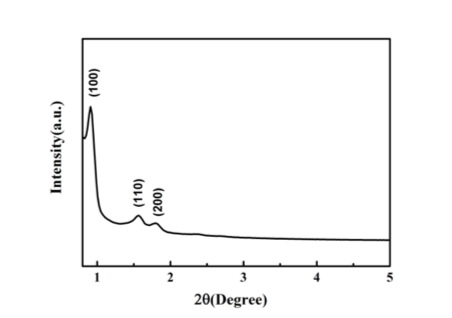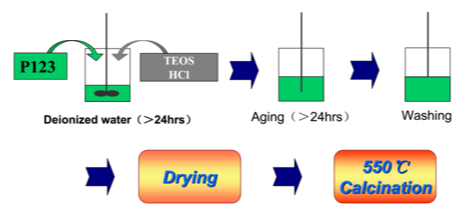-
SBA-15 Mesoporous Molecular Sieve
Aug 16, 2018 | ACS MATERIAL LLCSBA-15 molecular sieve is prepared by the hydrothermal method with triblock polymer pluronic P123 (EO20-PO70EO20), hydrochloric acid, tetraethyl orthosilicate (TEOS) and deionized water as raw materials. SBA-15 has an ordered structure that contains uni-dimensional mesopores of uniform size ranging from about 4 to 30 nm.1 Unique properties of SBA-15 include uniform and adjustable pore size, thick pore walls, superior hydrothermal/thermal and mechanical stability, high surface area, high pore volume and open pore structure. All of these properties render it highly valuable in a wide variety of applications.
Introduction
Since the first discovery in 1998, SBA-15 ordered hexagonal mesoporous silica has received a significant amount of attention.2 SBA-15 has a two-dimensional, hexagonal, through-hole structure with a space group p6mm.3 SBA-15 shows three XRD diffraction peaks, which can be assigned to (100), (110) and (200) crystal face diffractions (Figure 1). Furthermore, the silica on the SBA-15 framework is generally amorphous and no significant diffraction peak is observed in wide-angle XRD diffraction. The particle size of SBA-15 is 1~4 um and the BET surface area is above 550 m2/g.

Figure 1. Typical XRD Analysis of ACS Material Mesoporous Silica Molecular Sieve SBA-15
Synthesis
SBA-15 molecular sieve is prepared by the popular hydrothermal method4. Triblock polymer pluronic P123 (EO20PO70EO20) is used as the structure-direction agent and tetraethyl orthosilicate (TEOS) as the silica source. The typical synthesis process starts by first dissolving a P123 triblock copolymer in a solution that contains water and 38 wt% HCl. After stirring for 3 hours at room temperature, TEOS is added to the solution. The solution is then vigorously stirred for 10 minutes and placed at 40oC for 24 hours under static condition, followed by aging at 100 oC for 24 hours. To remove the copolymers, 1.5 g of particles are added to a mixture of 38wt% HCl and methanol and refluxed for 24 hours. Final particles are then separated by centrifugation, washed with distilled water, dried at 70 oC for 12hours and calcined at 550 oC. The molar composition of the mixture is SiO2 : 0.017P123 : 2.9HCl : 202.6H2O. The particle size and pore volume can be adjusted by the molar composition of the mixture, aging time and aging temperature.

Figure 2. XRD patterns of SBA-15 Mesoporous Molecular Sieve
There are also alternative approaches for preparing SBA-15 catalysts such as substitution of Si4+ by changing different cations, functionalization with different groups, changing the active phase component or varying the preparation method.5
Applications
Mesoporous silica particles are good candidates for drug delivery because of their biocompatibility, uniform structure, tunable pore size with narrow distribution, large pore volume, large surface area and ease of surface functionalization. SBA-15 has been extensively studied for both drug and gene delivery because of its ordered structure. For drug delivery, the drug loading capacity is affected by the pore size, surface area and drug-surface affinity.6
To expand the applications of SBA-15 mesoporous silica in catalysis, separation and sensor design, many researchers have focused on the preparation of organic-functionalized materials by the direct incorporation of organic groups through co-condensation or by grafting the organic groups onto the surface of the mesoporous silica. Aminopropyl-functionalized SBA-15 has been found to be useful for some base-catalyzed reactions including Knoevenagel reactions of carbonyl compounds with ethyl cyanoacetate, reactions of aldol condensation and the intramolecular addition of benzaldehyde and 2-hydroxyacetophenone to flavanone.7
SBA-15 can support various catalysts, including non-noble metal sulfides, metal phosphides, metal carbides and noble metals.8,9 Used in this manner, SBA-15 plays two main roles. First, it serves to disperse the active metal, which leads to higher metallic surface areas and subsequently higher catalyst activity. Second, it provides a method for influencing the selectivity of the products. In a test experiment, a series of Mo2C/SBA-15 catalysts with different Mo contents were prepared by temperature-programmed carburization of their oxide precursors and the Mo2C/SBA-15 catalysts exhibited excellent hydrodesulfurization (HDS) activity. Iron catalysts supported on SBA-15 and aluminum-containing SBA-15 were active toward the production of hydrocarbons via the Fischer-Tropsch process. Pt nanoparticles were embedded into the mesoporous silica SBA-15 using low power sonication. The Pt/SBA-15 catalysts demonstrated weak structure sensitivity with smaller particles demonstrating higher activity. Turnover rates for ethane hydrogenolysis of ethane on Pt particles increased monotonically with increasing metal dispersion.
Conclusion
SBA-15 is a versatile mesoporous silica material possessing highly ordered nanopores and a large surface area. It is widely employed as a good candidate for drug delivery and it can be modified with different cations, heteroatoms and organic functional groups. SBA-15 has expanding applications in catalysis, separation, and sensor design. Furthermore, SBA-15 supports various catalysts, including non-noble metal sulfides, metal phosphides, metal carbides and noble metals.
ACS Material Products:
FAQ
Q. What Is a Molecular Sieve Made of?
A. A molecular sieve is made from synthetic crystalline materials such as activated alumina, silica gel, or zeolites. Additionally, these materials have an even network of microspores that allow them to trap certain molecules based on their size.
Q. How to Use Molecular Sieve 3a?
A. Molecular size 3A is used to remove the water molecules from gas and liquid mixtures. It’s typically placed in a drying column where moisture passes through and gets dried or absorbed. Once it’s saturated, experts can be reactivated by heating at around 250–300°C to restore their adsorption ability.
Q. How a Molecular Sieve Works?
A. It works by absorbing certain molecules into its uniform pore structure. Larger molecules are excluded, while small molecules, such as CO₂ and H₂O, enter and become trapped. Thus, selective adsorption makes it perfect for purifying, drying, and separating gases and liquids.
Q.Where to Buy Substrate Molecular Sieve?
A. You can purchase substrate molecular sieves from scientific suppliers that provide pure and high-quality materials for industrial purification, research, and gas separations. ACS Material is a reputable name that provides top-quality chemicals and materials.
Q. What Is Molecular Sieve Chromatography?
A. Molecular sieve chromatography is the procedure also known as the size-exclusion method, which separates molecules according to their sizes. It involves a column filled with tiny porous beads that work like a filter. Consequently, larger molecules that cannot enter the pores must take a longer route to exit. The smaller molecules slip into the pores.
Q. What Is Zeolite Molecular Sieve?
A. A zeolite molecular sieve is a crystalline aluminosilicate with an even pore structure. It selectively absorbs gases and liquids based on their molecular size. Therefore, it becomes ideal for gas purification, catalysis, moisture control, etc.
Q. What Is a Molecular Sieve in a Pill Bottle?
A. To prevent tablets from oxidation and degradation, medicine or pill bottles often have molecular sieves desiccant that absorbs all the moisture inside and keeps them dry.
References
1. Huirache-Acuña, R., Nava, R., Peza-Ledesma, C.L., Lara-Romero, J., Alonso-Núez, G., Pawelec, B. and Rivera-Muñoz, E.M., 2013. SBA-15 mesoporous silica as catalytic support for hydrodesulfurization catalysts. Materials, 6(9), pp.4139-4167.
2. Wang X, Lin K S K, Chan J C C, et al. Direct synthesis and catalytic applications of ordered large pore aminopropyl-functionalized SBA-15 mesoporous materials. Journal of Physical Chemistry B, 2005, 109(5):1763-1769.
3. Chong A S M, Zhao X S. Functionalization of SBA-15 with APTES and characterization of functionalized materials. Journal of Physical Chemistry B, 2003, 107(46):12650-12657.
4. Song S W, K. Hidajat A, Kawi S. Functionalized SBA-15 Materials as carriers for controlled drug delivery: influence of surface properties on matrix-drug interactions. Langmuir, 2005, 21 (21): 9568-9575.
5. D J K, B C D, Frank Huggins, et al. SBA-15-Supported iron catalysts for Fischer−Tropsch production of diesel fuel. Energy & Fuels, 2006, 20(6): 2608-2611.
6. Hwang D H, Lee D, Lee H, et al. Surface functionalization of SBA-15 particles for ibuprofen delivery. Korean Journal of Chemical Engineering, 2010, 27(4):1087-1092.
7. Wainwright S G, Parlett C M A, Blackley R A, et al. True liquid crystal templating of SBA-15 with reduced microporosity. Microporous and Mesoporous Materials, 2013, 172(2):112-117.
8. Zhang H, Sun J, Ma D, et al. Unusual mesoporous SBA-15 with parallel channels running along the short axis. Journal of the American Chemical Society, 2004, 126 (24): 7440-7441.
9. Nakahira A, Hamada T, Yamauchi Y. Synthesis and properties of dense bulks for mesoporous silica SBA-15 by a modified hydrothermal method. Materials Letters, 2010, 64(19):2053-2055.